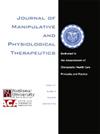穆里根活动技术和核心稳定练习对女性膝关节骨性关节炎患者的疗效:随机对照单盲研究》。
IF 1.4
4区 医学
Q4 HEALTH CARE SCIENCES & SERVICES
Journal of Manipulative and Physiological Therapeutics
Pub Date : 2024-01-01
DOI:10.1016/j.jmpt.2024.08.012
引用次数: 0
摘要
研究目的本研究的目的是比较在传统物理治疗(CP)方案中加入穆里根活动(MM)技术和核心稳定(CS)运动对膝关节骨性关节炎(KOA)女性患者的效果:研究对象包括 42 名确诊为双侧 KOA 的女性患者。研究对象被随机分为三组,CP 组(平均年龄:57.79 ± 7.43 岁)、MM 组(平均年龄:56.14 ± 6.95 岁)和 CS 组(平均年龄:54.36 ± 6.56 岁)。他们被分为 3 组,每周治疗 3 次,共治疗 4 周。分别使用视觉模拟量表、通用动态关节角度计和手持式测力计对疼痛强度、活动范围(ROM)和肌肉力量进行评估。平衡、有氧运动能力和功能水平则通过 30 秒坐立测试、6 分钟步行测试以及西安大略和麦克马斯特大学骨关节炎指数进行评估。诺丁汉健康档案对参与者的生活质量进行了评估:治疗后,各组的所有评估指标均有明显改善(P < .05)。与其他两种治疗方法相比,CS 能更有效地降低静息疼痛强度(P = .001)。据观察,MM 技术更能增加膝关节的屈曲 ROM(P = .001)。在平衡、功能水平、有氧能力和生活质量评估方面,MM 组和 CS 组均无优势(P > .05):我们的研究表明,CP、MM 技术和 CS 运动是治疗女性患者 KOA 的有效方法。研究结果显示,MM 技术在增加膝关节屈曲 ROM 方面更有效,而 CS 运动在降低 KOA 女性患者静息疼痛强度方面更有效。本文章由计算机程序翻译,如有差异,请以英文原文为准。
Effectiveness of Mulligan Mobilization Technique and Core Stabilization Exercises in Female Patients With Knee Osteoarthritis: A Randomized Controlled Single-Blind Study
Objectives
The aim of this study was to compare the effectiveness of the Mulligan mobilization (MM) technique and Core stabilization (CS) exercises added to the conventional physiotherapy (CP) program in female patients with knee osteoarthritis (KOA).
Methods
The study included 42 female patients diagnosed with bilateral KOA. Participants were randomly divided into 3 groups as CP group (mean age: 57.79 ± 7.43 years), MM group (mean age: 56.14 ± 6.95 years), and CS group (mean age: 54.36 ± 6.56 years). They were divided into 3 groups and treated 3 sessions per week for 4 weeks. Pain intensity, range of motion (ROM), and muscle strength were evaluated with visual analog scale, universal goniometer, and handheld dynamometer, respectively. Balance, aerobic capacity, and functional level were assessed with 30-second sit-to-stand test, 6-minute walk test, and Western Ontario and McMaster Universities Osteoarthritis Index. The quality of life of the participants was evaluated with the Nottingham Health Profile.
Results
After treatment, significant improvement was achieved in the all parameters evaluated in the groups (P < .05). CS was found to be more effective in reducing resting pain intensity than the other two treatment approaches (P = .001). It was observed that MM technique increased knee flexion ROM more (P = .001). There was no superiority of MM group and CS group over each other in balance, functional level, aerobic capacity, and quality of life assessments (P > .05).
Conclusion
Our study showed that CP, MM technique, and CS exercises were effective treatment approaches in the management of KOA in female patients. Results revealed that the MM technique was more effective in increasing knee flexion ROM, and the CS exercise was more effective in reducing resting pain intensity in female patients with KOA.
求助全文
通过发布文献求助,成功后即可免费获取论文全文。
去求助
来源期刊
CiteScore
3.00
自引率
7.70%
发文量
63
审稿时长
29 weeks
期刊介绍:
The Journal of Manipulative and Physiological Therapeutics (JMPT) is an international and interdisciplinary journal dedicated to the advancement of conservative health care principles and practices. The JMPT is the premier biomedical publication in the chiropractic profession and publishes peer reviewed, research articles and the Journal''s editorial board includes leading researchers from around the world.
The Journal publishes original primary research and review articles of the highest quality in relevant topic areas. The JMPT addresses practitioners and researchers needs by adding to their clinical and basic science knowledge and by informing them about relevant issues that influence health care practices.

 求助内容:
求助内容: 应助结果提醒方式:
应助结果提醒方式:


